Relax. Keeping bees is not Rocket Science. In fact, the less you know, the less you will have to “unlearn” along the way. I teach beginning beekeepers each year, and most are relieved to know that there is little chance of hurting your bees if you follow a few simple guidelines. Here they are:
1–Read One Good Bee Book From Start to Finish
There are many to choose from, and pretty much any beekeeping book will tell you all you need to know about the complex and extraordinary lifecycle of the honeybee. Some of my current favorites are:
“Song of Increase,” by Jacqueline Freeman. While not a how-to bee book, this book is an eloquent, deeply engaging inquiry into what bees want, and how they live.
“The Buzz About Bees,” by Jurgen Tautz. This book is expensive, but it is my best quick reference for all things bee.
“The Practical Beekeeper,” by Michael Bush. This book is also not cheap, however, everything in his book is also available for free on his website.
“Honeybee Democracy,” by Thomas Seeley. Seeley is an internationally recognized bee researcher and keeper. And—unlike many scientists—he is able to record his observations in a style that is engaging and very readable.
2–Download or Purchase “At the Hive Entrance,” by H. Storch
I’m not going to call this a book, exactly, because it is very small. I think of it more as a pocket guide that you will carry when you go sit by your bees. You can find this book to download online, but I picked up my copy at Amazon. Before the days of observation windows and removable combs, the only way to inspect your bees was to watch their comings and goings from the hive.
My first Warre hives had no viewing windows, but with this little guide in my pocket, I learned an incredible amount about my first hive by watching, listening, and being patient. Being a good observer, I believe, is the first skill you must acquire as a new beekeeper.
3–Decide what kind of a hive will work for you and your bees.
There are so very many hive styles to choose from these days. While the most popular remains the conventional Langstroth hive with removable combs, my simple program for new beekeepers favors a Warre hive.
Why? A Warre hive comes in small stackable boxes. It has simple wooden bars across the top. It takes up little space, and the small boxes are preferred by bees to larger hives. Smaller hives mean that the bees have less space to heat in the winter, and less comb to build in the summer.
Warres are not hives that invite a lot of inspection. The bees affix the honeycombs to the side of the boxes, so removing them can be messy—but I am advising that new beekeepers should probably not be tinkering around in the hive much anyway.
For your first year with bees, watching from the hive entrance or viewing window—pocket guide in hand—is a great way to be certain that your beekeeping practices will not harm your bees.
An time you go into a hive, you risk damaging the queen, spilling honey stores, smooshing bees, chilling the interior of the hive, and destroying the propolis seal that the bees maintain for their health.
And new beekeepers are nervous, clumsy and impatient. Ask me how I know this. Really. Ask me. I think that in my first year or two of beekeeping, all of my “helpful interventions” turned out to be benign at best and disastrous at worst for my hives.
With a few more years with bees under my belt, I’ve lost all that initial anxiety and self-doubt. Now, when I go into the hive, my hands don’t shake and I don’t hyperventilate. This sense of calm comes with time.
A three-box Warre is as large a hive as you will ever need as a backyard beekeeper.
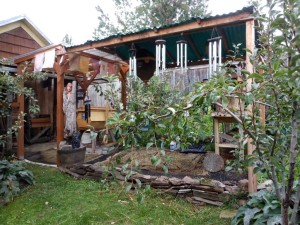
I live in the Pacific Northwest, so to keep my hives from being drenched summer to winter, I built a covered ‘carport’ to house most of my hives.
4–Put Your Hive in the Right Place
Correctly siting a hive is actually a whole article in itself, but the basic considerations are these:
- Place the hive where the entrance can face east or south.
- Put the hive on a stand, the taller the better (a table is good, or a small dresser, or cement blocks. Just get it off the ground. Bees are aboreal creatures!)
- Put the hive in an area where you will not be passing in front of it constantly. Bees will bump you if you wander through their flight path a lot. If you need to have the hive in a heavily trafficked part of your yard, you can put a sheet of lattice board about a foot or two in front of the hive. The lattice will encourage the bees to fly up, and they will pass over your head instead of bumping into your face.
- Shade or cover from the hottest sun of the day is a good thing, if your yard offers such a thing. In my yard, I’ve put patio umbrellas over some of my hives.
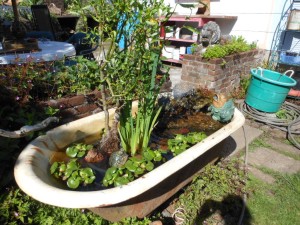
This is my bees’ favorite watering station. In summer there are hundreds of lovely, humming bees gathering in this old tub.
5–Put out a water source for your bees.
They will choose the first watering hole they find when you bring them home, and you do NOT want that watering hole to be your neighbor’s pool or fountain. A birdbath or a large tub of water—something you can easily keep filled—is critical. You can float corks, sticks, or plants in your watering site so that the bees will not drown trying to access it.
6–You are Ready for Bees!
I think the most important task for a new beekeeper is sourcing local bees. You do NOT want to purchase “package bees” through the mail. I’ve written about why this is such a bad idea HERE, but to paraphrase, package bees will be coming from out of your area and are unsuited to your weather and foraging conditions.
Package bees are delivered with a queen that has been artificially inseminated, which means that her genetics are very limited. These bees don’t have the vigor of local, open-mated stock. The chance of these bees dying is great. You want local bees from local breeders. Or—and this is best—you want to catch a swarm.
This may be too much to ask of a new beekeeper, but if you have a sense of adventure, gathering swarms is fun, the bees are healthy or they would not be swarming in the first place, and they are free!
Do a bit of Googling, and you’ll find all you need to know about swarm catching. It is safe and exciting and you’ll be talking about your swarm adventures for years to come.
7–Put Your Bees in Your Hive and Stand Back.
Once your bees have been escorted into your hive, you have done all you need to do. Now, sit back, watch, learn. Read some more, join a local bee club, get into online bee forums.
And grow bee food. Lots of bee food. All beekeepers need to be gardeners, first and foremost.
Your bees have been given a safe, dry home in a place where vandals will not harass them. They have water. Trust them to take care of the rest.
In the years to come, you will learn plenty as you go, but simply offering your bees a good, safe place to be is enough. The most current science backs this up: The bees that do best are those that are allowed to Natural Selection to work with them.
You are doing your bees no disservice by starting slow and taking baby steps into your beekeeping life. And what a fun, satisfying life it is!

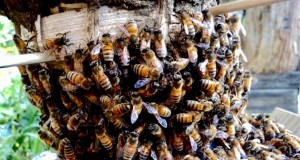
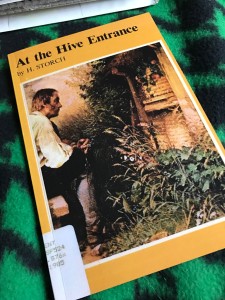
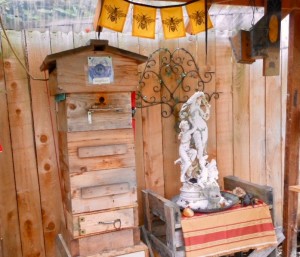
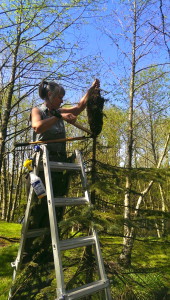









5 Comments
I am just starting my bees this year and have caught a “swarm” from nearby and now they are doing very well but I have a problem..there are ants in my bee hives I know you are supposed to put a container with oil in it to deter the ants but I would like to know if I could use water instead of oil,,,,or must you use oil and what type oil should be used? Baby oil like for the ant trap on a hummingbird feeder?I would appreciate any hel from you on this!!!!!
Yes, you’re right! The Practical Beekeeper by Michael Bush is one of the great beekeeping books, thank-you for sharing some others, I’ll take a read!
…”Package bees are delivered with a queen that has been artificially inseminated,…” you’ve got to be joking, right? A package of bees with an artificially inseminated queen would cost you more than the hive setup alone. Artificially inseminated queens go for $300-$500 a piece.
I’ve followed your work, so I understand the angle that you are writing from, but this article doesn’t contain helpful info for new beekeepers to get started. Michael Bush’s book is fantastic, but it is not a basic beekeeping book.
Hello, great article! Are you a treatment free beekeeper it looks like you live in the Pacific Northwest you said. I am a new beekeeper this year and have a few questions for someone who is a treatment Free beekeeper. If you would be willing to answer him that would be great! Do you use insulation or not it seems to be controversial. Would you feed sugar water after the beers have swarmed And don’t seem to have any honey stored?
Very informative. I live in Bahamas, and have 2 hive-boxes in my yard, the bees seem to be building them out pretty good. I will create a water container for they to access water, this week.